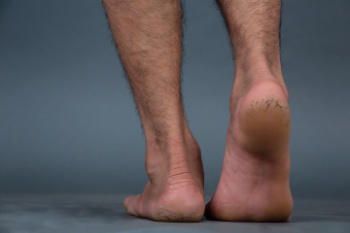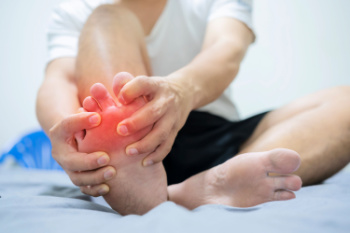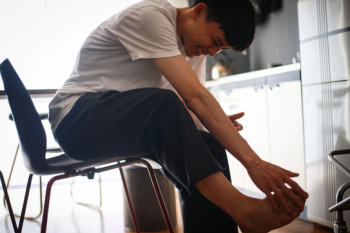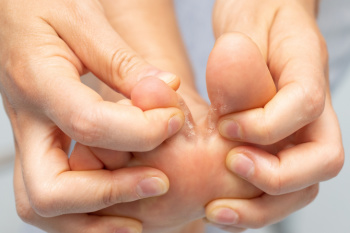Items filtered by date: February 2024
Relief From Cracked Heels

Cracked heels can be bothersome and even painful. They often occur due to dry skin and excessive pressure on the feet, especially while wearing open-back shoes or spending a lot of time on hard surfaces. Moisturizing the heels regularly with emollients helps restore suppleness and prevent further cracking. If the condition persists despite conservative treatment, it is suggested that you visit a podiatrist. Possible treatments include heel cups to redistribute weight and support the heel pad, or medical glue to help cracks heal. Podiatrists can provide personalized care for optimal foot health, and also address any underlying conditions, such as diabetes, peripheral vascular disease, and neuropathy, which may contribute to cracked heels. If you have developed cracked heels, it is strongly suggested that you confer with a podiatrist who can provide effective treatment options that are correct for you.
If the skin on your feet starts to crack, you may want to see a podiatrist to find treatment. If you have any concerns, contact Richard P. Jacoby, DPM from Extremity Health Centers. Our doctor can provide the care you need to keep you pain-free and on your feet.
Cracked Heels
It is important to moisturize your cracked heels in order to prevent pain, bleeding, and infection. The reason cracked heels form is because the skin on the foot is too dry to support the immense pressure placed on them. When the foot expands, the dry skin on the foot begins to split.
Ways to Help Heal Them
- Invest in a good foot cream
- Try Using Petroleum Jelly
- Ease up on Soaps
- Drink Plenty of Water
Ways to Prevent Cracked Heels
- Moisturize After Showering
- Skip a Shower
- Keep Shower Water Lukewarm
- Don’t Scrub Your Feet
If you are unsure how to proceed in treating cracked heels, seek guidance from a podiatrist. Your doctor will help you with any questions or information you may need.
If you have any questions, please feel free to contact one of our offices located in Scottsdale and Buckeye, AZ . We offer the newest diagnostic and treatment technologies for all your foot care needs.
We Can Treat Your Foot or Ankle Pain
Understanding Pain and Discomfort of Toe Arthritis

Arthritis in the toe, a common ailment affecting many individuals, manifests through various symptoms that can significantly impact daily life. Persistent toe pain, particularly during movement or weight-bearing activities, are hallmark symptoms of toe arthritis. Individuals may experience stiffness and limited range of motion in the affected toe, making tasks like walking, bending, and standing challenging and painful. Swelling and inflammation surrounding the toe joint are also common symptoms of arthritis, indicating underlying joint damage and inflammation. As arthritis progresses, individuals may notice changes in the appearance and alignment of the toe, such as swelling, deformities, and bone spurs. Additionally, toe arthritis can cause instability and weakness in the affected joint, leading to difficulty bearing weight and maintaining balance. If you are experiencing toe pain, it is strongly suggested that you consult a podiatrist who can diagnose the cause, and offer appropriate relief and treatment options.
Toe pain can disrupt your daily activities. If you have any concerns, contact Richard P. Jacoby, DPM of Extremity Health Centers. Our doctor can provide the care you need to keep you pain-free and on your feet.
What Causes Toe Pain?
Most severe toe pain is caused due to a sports injury, trauma from dropping something heavy on the toe, or bumping into something rigid. Other problems can develop over time for various reasons.
Toe pain can be caused by one or more ailments. The most common include:
- Trauma
- Sports injury
- Wearing shoes that are too tight
- Arthritis
- Gout
- Corns and calluses
- Hammertoe
- Bunions
- Blisters
- Ingrown toenails
- Sprains
- Fractures (broken bones)
- Dislocations
When to See a Podiatrist
- Severe pain
- Persistent pain that lasts more than a week
- Signs of infection
- Continued swelling
- Pain that prevents walking
Diagnosis
In many cases the cause of toe pain is obvious, but in others, a podiatrist may want to use more advanced methods to determine the problem. These can range from simple visual inspections and sensation tests to X-rays and MRI scans. Prior medical history, family medical history, and any recent physical traumatic events will all be taken into consideration for a proper diagnosis.
Treatment
Treatments for toe pain and injuries vary and may include shoe inserts, padding, taping, medicines, injections, and in some cases, surgery. If you believe that you have broken a toe, please see a podiatrist as soon as possible.
If you have any questions please feel free to contact one of our offices located in Scottsdale and Buckeye, AZ . We offer the newest diagnostic tools and technology to treat your foot and ankle needs.
Symptoms and Risk Factors of Gout

Gout is caused by the accumulation of uric acid crystals in joints, often affecting the big toe. Gout is notorious for its intense pain, which frequently flares up at night. Although commonly associated with men over 45, gout can develop in anyone at any age. This arthritic condition stems from the body's inability to adequately process purines, which are natural substances found in the body. This inability results in the formation of uric acid. When uric acid levels become elevated, sharp urate crystals form and deposit in joints, leading to inflammation, swelling, and excruciating pain. While the big toe is a frequent target, gout can affect any joint and often strikes suddenly, even disrupting sleep with its severity. Dietary factors play a significant role in gout development, with diets high in red meat, seafood, and fructose-containing beverages increasing the risk. Alcohol consumption and obesity also increase susceptibility to gout. Symptoms can include agonizing pain, swelling, warmth, and redness at the affected joint, which may last up to a week before subsiding. Gout is not curable, but it can be managed with the help of lifestyle and dietary changes and treatment from a podiatrist. If you suffer from the symptoms of gout, it is suggested that you are under the care of a podiatrist who is medically trained to manage this ailment.
Gout is a foot condition that requires certain treatment and care. If you are seeking treatment, contact Richard P. Jacoby, DPM from Extremity Health Centers. Our doctor will treat your foot and ankle needs.
What Is Gout?
Gout is a type of arthritis caused by a buildup of uric acid in the bloodstream. It often develops in the foot, especially the big toe area, although it can manifest in other parts of the body as well. Gout can make walking and standing very painful and is especially common in diabetics and the obese.
People typically get gout because of a poor diet. Genetic predisposition is also a factor. The children of parents who have had gout frequently have a chance of developing it themselves.
Gout can easily be identified by redness and inflammation of the big toe and the surrounding areas of the foot. Other symptoms include extreme fatigue, joint pain, and running high fevers. Sometimes corticosteroid drugs can be prescribed to treat gout, but the best way to combat this disease is to get more exercise and eat a better diet.
If you have any questions please feel free to contact one of our offices located in Scottsdale and Buckeye, AZ . We offer the newest diagnostic and treatment technologies for all your foot and ankle needs.
What Happens if Athlete's Foot Is Untreated
 Athlete’s foot is a fungal infection that causes blisters and peeling skin on the feet. This contagious infection is generally treated with topical antifungal medications. If left untreated, athlete's foot can lead to more severe problems than the itching and redness associated with the infection. If ignored, the infection can spread to other parts of the foot, such as the toenails or the soles of the feet. As the condition progresses, it may result in painful blisters, cracks, and open sores, making daily activities like walking or standing uncomfortable. In some cases, untreated athlete's foot can contribute to the development of secondary bacterial infections, which can include swollen and painful feet. These secondary infections can also cause fever and lymph node infections. Some patients also experience allergic reactions to the initial fungal infection, causing blisters on the infected area. Podiatrists can prescribe antifungal medications and provide more information on foot hygiene to effectively quell a case of athlete’s foot. If you suspect you have athlete’s foot, it is suggested that you seek prompt treatment from a podiatrist to treat the infection and prevent it from worsening.
Athlete’s foot is a fungal infection that causes blisters and peeling skin on the feet. This contagious infection is generally treated with topical antifungal medications. If left untreated, athlete's foot can lead to more severe problems than the itching and redness associated with the infection. If ignored, the infection can spread to other parts of the foot, such as the toenails or the soles of the feet. As the condition progresses, it may result in painful blisters, cracks, and open sores, making daily activities like walking or standing uncomfortable. In some cases, untreated athlete's foot can contribute to the development of secondary bacterial infections, which can include swollen and painful feet. These secondary infections can also cause fever and lymph node infections. Some patients also experience allergic reactions to the initial fungal infection, causing blisters on the infected area. Podiatrists can prescribe antifungal medications and provide more information on foot hygiene to effectively quell a case of athlete’s foot. If you suspect you have athlete’s foot, it is suggested that you seek prompt treatment from a podiatrist to treat the infection and prevent it from worsening.
Athlete’s foot is an inconvenient condition that can be easily reduced with the proper treatment. If you have any concerns about your feet and ankles, contact Richard P. Jacoby, DPM from Extremity Health Centers. Our doctor will treat your foot and ankle needs.
Athlete’s Foot: The Sole Story
Athlete's foot, also known as tinea pedis, can be an extremely contagious foot infection. It is commonly contracted in public changing areas and bathrooms, dormitory style living quarters, around locker rooms and public swimming pools, or anywhere your feet often come into contact with other people.
Solutions to Combat Athlete’s Foot
- Hydrate your feet by using lotion
- Exfoliate
- Buff off nails
- Use of anti-fungal products
- Examine your feet and visit your doctor if any suspicious blisters or cuts develop
Athlete’s foot can cause many irritating symptoms such as dry and flaking skin, itching, and redness. Some more severe symptoms can include bleeding and cracked skin, intense itching and burning, and even pain when walking. In the worst cases, Athlete’s foot can cause blistering as well. Speak to your podiatrist for a better understanding of the different causes of Athlete’s foot, as well as help in determining which treatment options are best for you.
If you have any questions please feel free to contact one of our offices located in Scottsdale and Buckeye, AZ . We offer the newest diagnostic and treatment technologies for all your foot and ankle needs.

